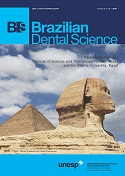Synthesis and morphological characterization of Polycaprolactone (PCL) membranes with tara extract (Caesalpinia spinosa)
DOI:
https://doi.org/10.14295/bds.2019.v22i2.1688Abstract
Objective: This study aimed the synthesis and morphological characterization of PCL electrospun fibers containing tara extract. Material and Methods: For this, tara extract synthesis was performed by two different extraction methods: rotary evaporator and extractor soxhlet. Then, two solutions were prepared by dissolving 3g of PCL in 2mL of Acetone. The first solution used 0.4 mL tara extract obtained by RE and the second solution used 0.4 mL tara extract obtained by SE. After the solutions electrospinning, under different parameters, obtaining It was obtained the experimental groups: ChTa 1 nanofibers with RE extract, under 12 Kv; ChTa 2 nanofibers with RE extract, under 15 Kv; ChTa 3 nanofibers with ES extract, under 12Kv and ChTa 4 nanofibers with ES extract, under 15kV. Scanning electron micrographs were performed for morphological analysis. Results: Fiber formation was observed for all parameters. About the fiber diameter: ChTa 1 presented a mean of 0.82 ± 0.36?m, ChTa 2 1.232 ±0471?m, ChTa 3 1.469 ± 0.614?m and ChTa 4 1.017 ± 0.417. Also the beads formation was analyzed: ChTa 1 group presented 8 beads, ChTa 2 presented 5, ChTa 3 presented 30 and ChTa 4 presented 15 beads. Conclusion: It can be concluded that it is possible to obtain an effective synthesis of electrospun membranes of PCL and Caesalpinia spinosa extract, indicating a potential of therapeutic application for lesions such as prosthetic stomatitis.
Keywords
Candidiasis; Nanofibers; Tannins.
Downloads
Downloads
Published
How to Cite
Issue
Section
License
Brazilian Dental Science uses the Creative Commons (CC-BY 4.0) license, thus preserving the integrity of articles in an open access environment. The journal allows the author to retain publishing rights without restrictions.
=================




























